No matter what your level of expertise is with SEO, you’re always somewhat limited by the tools you use.
Thankfully, there are a number of excellent tools available online, many at no cost. These tools are particularly useful if you’re just starting out in SEO like me.
Today I will take a look at the Top 10 free SEO tools for beginners.
Google Analytics
Google Analytics (@googleanalytics) is an SEO’s bread and butter. I’m currently working my way through their awesome qualification program.
Aimed toward marketers, Google Analytics provides detailed statistics about a website’s traffic and traffic sources. In the Dashboard, you can view these statistics for any period of time of your choosing.

The menu on the left gives you access to even more detailed reports about your audience, traffic sources, content, and conversions.
The Audience report provides demographic information about your audience, including which country they visited from and which language they speak. It also reveals what platform and/or browser they used to access your site, and their behaviour on your website (how long they stayed for on average, how many pages they visited on average, etc.).
The Traffic Sources overview will tell you how many visitors to your website came from search engines, direct visits, social networks, or referring sites. Using this information, you can determine where you need to focus your efforts (e.g. if most of your visits are coming from social networks but very few are coming from search engines, that means your social media strategy is good but your SEO could use work).
The Content report shows you which pages of your website are attracting the most traffic; you can see metrics such as the number of visits, average visit duration, bounce rate, and % new visits for each and every page on your website.
The Conversions report shows you how many of your goals (e.g. form submission, sales) have been completed and the conversion rate for each one. This is particularly useful if you’re running an e-commerce site.
All this information is very helpful for planning and tracking your Web marketing strategy.
Google Webmaster Tools
Google Webmaster Tools (@googlewmc) is a free service for webmasters that allows you to check and monitor the indexing status of your website. The many tools it offers allow you to:
- Submit and check a sitemap
- Check the crawl rate of your site
- Get a list of internal, external, and broken links to your site
- See what keywords people are using to find your site, and their click-through rates.
Perhaps the most useful of these tools for SEO purposes is the keywords tool. Whereas Google Analytics shows you total traffic to your website from search engines, Google Webmasters Tool shows clicks and impressions for each keyword separately. With this information, you can determine what keywords you want to target in your SEO or SEM campaigns.
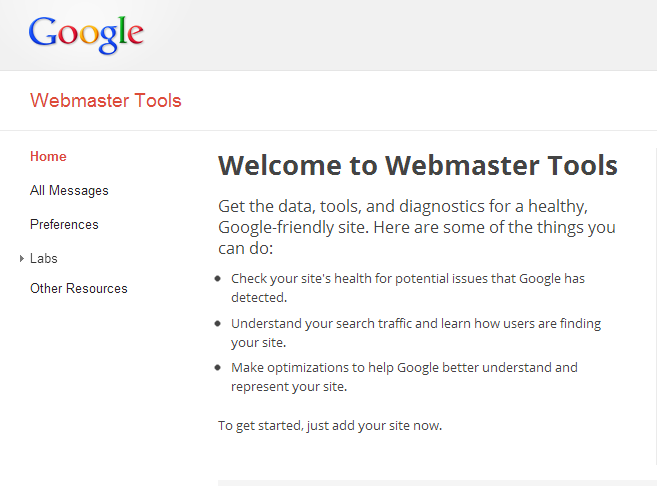
For troubleshooting, Google Webmaster Tools provides a list of crawl errors and even allows you to Fetch as Google to see a page as Google sees it. This can be invaluable for figuring out why a page is performing poorly in search results.
Bing Webmaster Tools
Bing Webmaster Tools (@duaneforrester) is essentially the same as Google Webmaster Tools, but for Bing. Recent reports show that although Google is the most used search engine with 67% market share, Bing is still a force to be reckoned with slightly more than 16%. In short, if you want your website to attract more people, you need to make sure it’s ranking with Bing too.
Bing Webmaster Tools helps you to do just that. Just as in Google Webmaster Tools you can see data about your keywords, traffic sources, backlinks, and crawl errors. The Fetch as Bingbot tool works the same way as the Fetch as Google tool, allowing you to see a page the way Bing sees it for troubleshooting purposes.

A great feature for SEO purposes is the SEO Analyzer, which can be found under Diagnostics & Tools in the navigation menu. The SEO Analyzer will download and analyze your webpage and provide a list of errors organized by priority. In this example, there are multiple H1 tags in the source code, which isn’t good.
The Analyzed pane shows a view of your webpage with each of the troubleshooting items noted where they reside on the page, giving you an easy way to identify and quickly fix errors that might be affecting your ranking.
Google Trends
Google Trends (@GSearchTrends) is a great tool for performing keyword research. Let’s say you own a website that sells custom bracelets. Naturally, you want your website to rank near the top of Google’s results page for keywords related to this term. If you go to Google Trends and type in custom bracelets, you’ll see this:
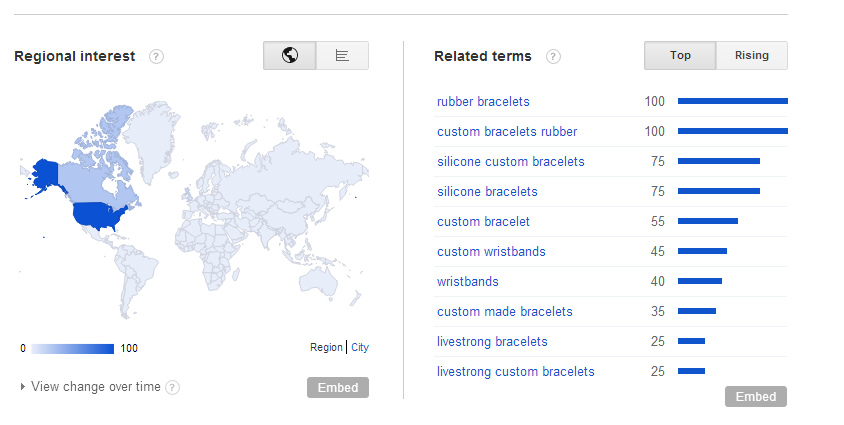
The map tells you where most of the searches for this term are coming from (in this case, almost entirely the U.S. and Canada). More interesting is the Related terms section, which suggests related keywords for you based on popularity. Now you have an idea of other keywords you might want to work into your SEO campaign.
Google Trends is a great place to start when developing content for SEO purposes. You can look at this information as a list of topics you could potentially write a blog post about for your website (“Everything You Need to Know about Rubber Bracelets,” “Why Silicone Bracelets are Hot,” etc.).
Basing your content around what people are searching for is a sure way to boost your rankings.
Google AdWords Keywords Tool
Google Adwords (@adwords) is primarily used for creating paid search advertising campaigns, but its Keywords Tool has great applications for SEO. Similar to Google Trends, you can punch in a keyword and the tool will provide you with a list of 100 related terms. You can even filter your results by category, country, language, and devices.
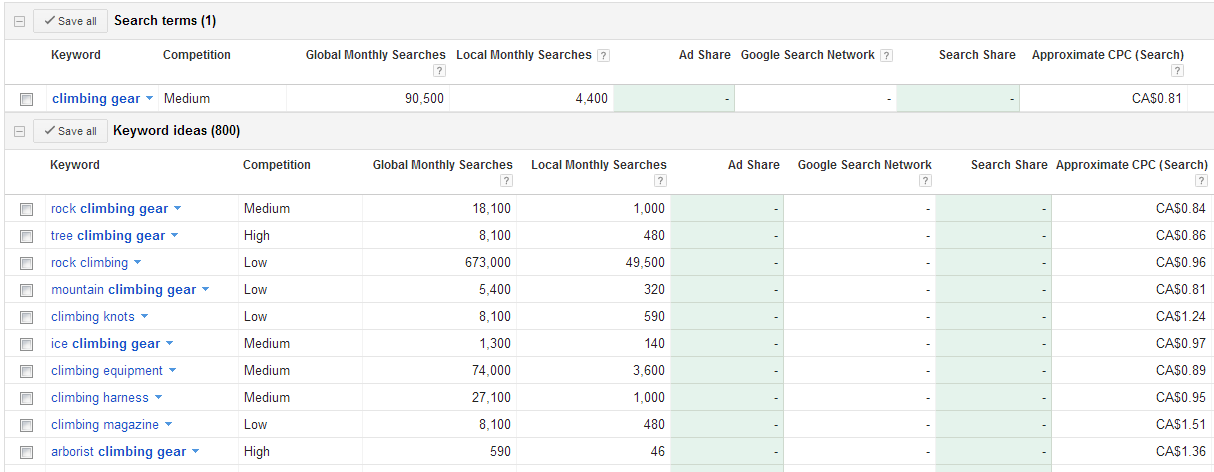
These are the keyword results for the term climbing gear. For SEO, we’re not as interested in the CPC rates, but the global and monthly search numbers tell us a lot about what terms people are searching for.
If you ran a website that sold different kinds of climbing gear, you would want to make sure to target these high-volume keywords in your content. You could use this information to create separate, keyword-rich webpages focused on each kind of climbing gear (rock climbing gear, tree climbing gear, ice climbing gear, etc.). This would increase the chances of your website being found by users searching for each of these terms.
SEOQuake
SEOQuake (@SEOQuake) is an SEO plug-in extension that is available for Google Chrome and Firefox. It displays a ton of different SEO parameters for any webpage, including Google PageRank, Google Index, Bing index, Alexa Rank, and a whole bunch more. The parameters can also be made visible on search engine results pages or SERPs.

Here we see SEO parameters displayed for the Apple iPad webpage. This information could be very useful when trying to determine the authority of a webpage for link-building purposes.
Under the SEOQuake preferences, you can determine which parameters you want to display and even specify a list of domain names for which the toolbar will be turned off.
Warning: Using a large amount of parameters very frequently may lead to a ban from search engines. If that happens, you will need to delete your cookies and change your proxy server.
MozBar
The SEOMoz mozBar (@SEOmoz) is another plug-in extension available for Chrome and Firefox, with some more advanced features. A paid version is available that gives you access to additional metrics (such as the number of linking root domains) and links to SEOMoz’s suite of tools. However, the free version is still quite valuable for SEO purposes.
The mozBar provides all the standard metrics such as PageRank and Domain Authority, and like SEOQuake, it can be accessed as either a toolbar or as an overlay in SERPs.
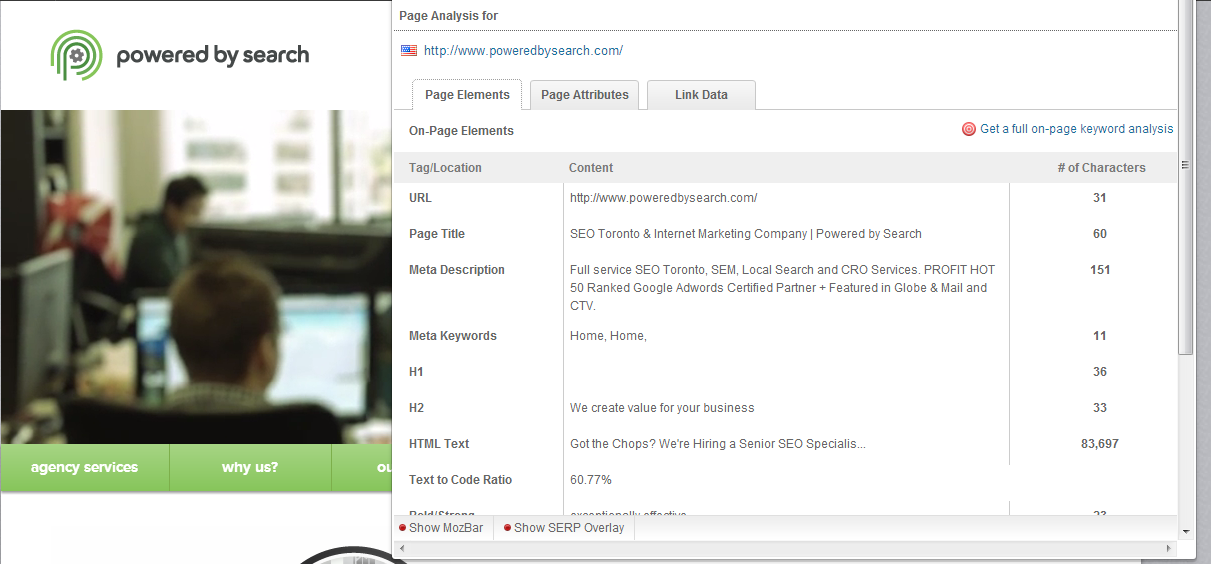
Here we can see the part of the page analysis for our homepage, broken into three sections: page elements, page attributes, and link data.
Another useful feature is the Highlight Links tool. This is particularly useful for distinguishing “dofollow” links (highlighted in green) from “nofollow” links (highlighted in pink). Since only dofollow links pass authority to the destination page, this is a crucial distinction for SEO.
For a complete overview of this tool, check out my colleague Michael Smith’s ultimate guide to the MozBar SEO extension.
Open Site Explorer
There are a number of free online tools that allow you to check a website’s backlinks, but I like SEOMoz’s Open Site Explorer (@SiteExplorer) because it has a nice, clean appearance and there are no annoying pop-ups. Simply enter in a URL and the tool will provide you with a list of webpages linking to your domain. You can filter the information by Top Pages, Linking Domains, and Anchor Text.

Another great feature of Open Site Explorer is that it allows you to compare the backlinks and link metrics for up to 5 websites. This can be very useful for determining the quality of your client’s website against some of its competitors.
It’s worth pointing out that unless you sign up for a paid SEOMoz PRO membership, you will be limited in the amount of information you can view. As a guest user, you will only be able to see full information (including Link Anchor Text, Page Authority, and Domain Authority) for 5 of your backlinks. You will also be limited to running 3 reports a day.
We asked SEOMoz founder Rand Fishkin to tell us about Open Site Explorer and here’s what he had to say:
“OSE was built to make exploring the web’s link graph useful, usable, and enjoyable. We do a ton of behind-the-scenes work to make the application fast, including sorting and filtering on metrics we know marketers need. There’s CSV export so you can play around even more in Excel, but we wanted to create an experience that would let anyone, even those who aren’t Excel jockies, get the data they need, fast.If you haven’t checked out OpenSiteExplorer in a while, you should! There’s a new tab called “just discovered” that shows links we’ve found extremely recently – as fast as 4 minutes old. We heard from users that speed of discovery was a big need, and put together this feature in just a few months.”
Hubspot Marketing Grader
Hubspot’s Marketing Grader (@Hubspot) is a great tool that provides a free analysis of your website’s marketing effectiveness. You simply need to enter your website’s URL, and in a matter of seconds the Grader will provide you with an overall marketing score on a 1-100 scale, based on over 30 different factors.

I ran a report for my own personal website, which I recently set up. Clearly, it still needs a lot of work. A great thing about the Marketing Grader is that it provides you withactionable suggestions and links to resources that can help you improve in areas where you are lacking. These suggestions are broken down to help out with the top of the funnel, the middle of the funnel, and your analytics.
In my case, to help me generate more traffic at the top of my funnel, it suggested I increase my blogging frequency and get more inbound links to my website. It then directed me to one of Hubspot’s free ebooks on business blogging.
The report includes a section on SEO, including how many of your webpages are indexed by search engines, your mozRank, and how many other pages are linking to you. If your website is linked with your social media profiles, it will also let you know how effective your social media strategy is, based on things like the frequency of your tweets and how many times you’ve been mentioned on Facebook.
All this information is essential for determining areas of improvement for a website, which will help to boost both conversions and search engine rankings.
Check My Links / LinkChecker
Check My Links by developer Paul Livingstone (@ocodia) and LinkChecker by Kevin Freitas (@fraydmedia) are two great extensions for Google Chrome and Mozilla Firefox, respectively. They’re fairly simple in terms of functionality, but they’re also very useful.
Both extensions automatically examine the links on a webpage and display which ones are working (in green) and which ones are broken (in red).
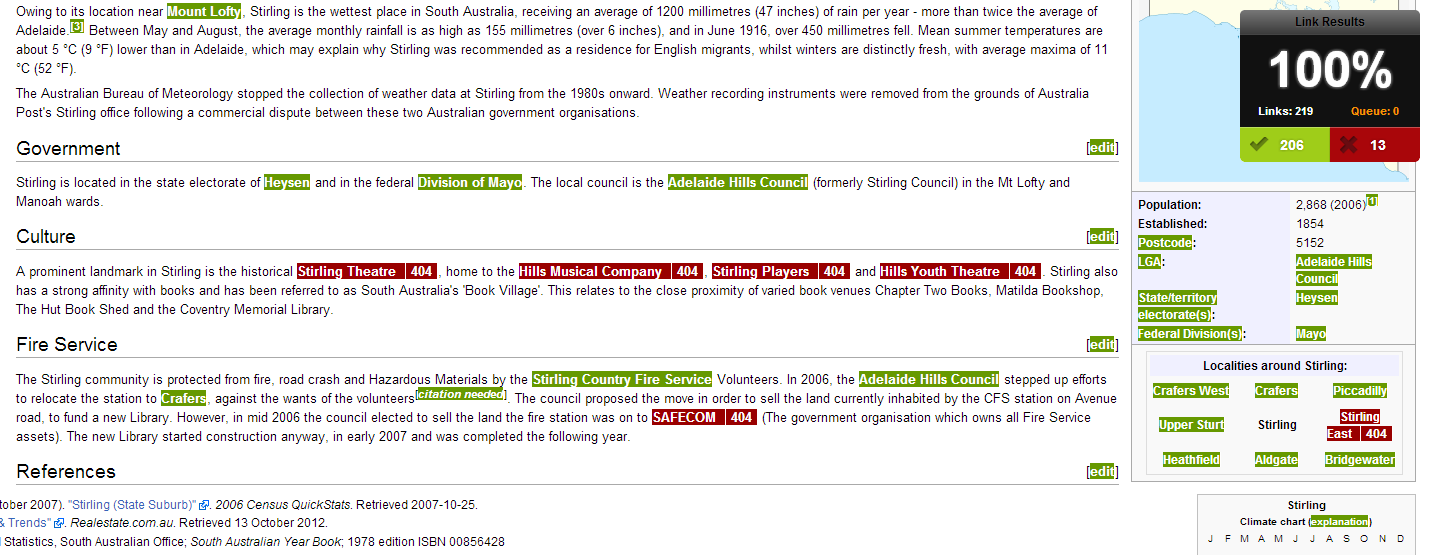
Not only is this good for identifying problems with your own webpage or a client’s webpage, it also opens up possibilities for link building. Most webmasters would appreciate you reaching out to them and pointing out a broken link. You could even suggest replacing that broken link with a link to your client’s website.
Check My Links is one of the most popular SEO extensions for Chrome, with 25,000 installs and counting. In Paul’s own words:
“I work in a web team for a public sector organisation, and our content editors wanted a way to quickly validate links on pages before pushing them live. I also wanted to understand Chrome extensions a bit more, so this ticked both boxes. It’s definitely not the tool you should be using if you want to do site-wide link validation, but for quick page-specific checks, it’s really handy (and fast). The extension is also pretty easy to understand, thanks to it’s ability to highlight broken links on the page.”
If you love this tool and want to donate to it’s upkeep, there are Paypal and Flattr links on the “Options” page of the extension. The source code for the extension is published under the MIT License and is available on Github.
I’m a Chrome user myself so Check My Links is the extension I’m familiar with, but if you use Firefox, LinkChecker is equally good. In Kevin’s words:
“LinkChecker came from a personal need to easily troubleshoot whether links on a webpage were good or not. I wanted a simple visual tool rather than spider apps that return a huge, mess list of URLs.”
As we learned when we polled SEO experts about their top 3 SEO tools, sometimes the simplest tools are the best. LinkChecker and Check My Links are two great examples of this.
There you have it: the top 10 free tools I have found most useful in my own introduction to SEO. It’s not an exhaustive list by any means, but it’s a good place to start.
Now it’s your turn. Are there any other great free SEO tools out there that I missed? Let me know in the comments!
Read more: http://www.poweredbysearch.com/top-free-seo-tools-beginners/#ixzz3c5H7gzu5
Under Creative Commons License: Attribution
Follow us: @poweredbysearch on Twitter | poweredbysearch on Facebook








0 comments:
Post a Comment